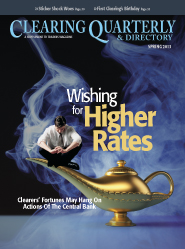Please give us a break and “tighten” is what many clearing industry executives are saying.It is the quiet plea to the nation’s central bank, the Federal Reserve, from many clearing executives. These executives are living through the unintended consequences of easy monetary policies, policies designed to revive the economy. However, the low interest rates over the past five years, clearing brokerage executives privately complain, have created an unintended victim: their brokerages.

Executives privately say that dirt-cheap money and interest rates near zero are hurting both the brokerages and their clients.
Earning nothing in brokerage accounts is “bad for the client and it’s bad for the brokerage,” said Bill Yancey, a longtime clearing executive who now works with First Southwest Company in Dallas. Clients grumble, sometimes taking accounts elsewhere, and firms see what was once a healthy revenue stream disappearing, industry observers say.

Cheap money has made the clearing brokerages’ money market/sweep accounts useless products and, in the process, damaged relationships between clients and brokerages.
“It affects the entire brokerage industry, particularly retail firms, because of the importance of cash to the economic model,” explained Stephen Langlois, chief administrative officer for Fidelity Investments’ National Financial. He added that the problem is “a macroeconomic issue and that no one can hide from it.”
A former clearing brokerage executive agrees.
“It’s very difficult to make money with these kinds of rates and these kinds of spreads,” said Robert Mumby, who runs his own consulting firm, RM Associates, in Baltimore.
Yancey, First Southwest’s managing director for clearing and execution services, will say publicly what many of his industry colleagues won’t: He hopes this year the Federal Reserve will begin to slowly reverse its policy.
If the Federal Reserve merely raised interest rates by 50 basis points this year, “it would be a good beginning that could help the industry tremendously,” Yancey said.
See Sidebar: Cheap Money
Why are the actions of the central bank so important?
Clearing brokerages, especially those without a captive client base, once earned significant revenues from interest-rate-sensitive services. This money, for some firms, has represented about a third of their revenues, industry observers say.
“Clearing firms generate revenues in several ways, including transaction charges, activity charges, margin interest and revenues based on activity levels,” according to a report by the Aite Group, “Best Practices for U.S. Broker/Dealers: Evaluating Fully Disclosed U.S. Clearing Firms.”
The 2009 report, in estimating the annual revenues of the average retail clearing firm, placed margin interest at 27 percent and money market balances at 10 percent. Fees made up 15 percent, mutual fund balances 13 percent. Trading comprised the other 35 percent of estimated clearing brokerage revenue, according to the report.
Sweep funds, in ensuring that the money market fund NAV doesn’t fall below a dollar, operate based on rebates that come from high balances and help ensure the fund can run a profit for both the brokerage and the investor.
But sweep funds have been a problem, industry executives say, because commercial paper yields have been so low.
“There hasn’t been enough juice in the commercial paper market place to pay for the fund management fees and provide a positive return, after all the expenses, to the investors,” said Doug Dannemiller, a wealth management and clearing industry consultant. Dannemiller is the founder of the consulting firm LaRoche Research in Duxbury, Mass.

The bottom line for these clearing brokerages is that formerly strong revenues sources have been falling and will likely continue to fall as the Federal Reserve pursues its zero-interest-rate policy (see sidebar: “Fed Remains Committed to Cheap Money”). That’s bad news for firms that have been depended on these revenues.
See Sidebar: “We’ll Pass On This One”
“They have been decimated,” Dannemiller said.
Five years ago before the Fed’s celebrated quantitative easing, he said, the margin/sweep account business generated about 30 percent of the revenues of the average retail clearing brokerage. Today about 10 percent of revenues come from that business, he estimated.
Dannemiller also argues that, over the last five years, annual retail industry clearing revenues-not including self-clearing firms-have dropped from $2.3 billion to $1.8 billion. Cheap money, he added, has also magnified the trend of fewer firms offering fully disclosed clearing services.
“In this difficult environment, clearing brokerages are seeing one of their key revenue sources hurt,” he said. Dannemiller also affirmed that the biggest institutional brokerages have been hurt, too. But, given their greater resources and often captive client base, they are less vulnerable to problems, since many of their clients will stay no matter what the interest rates.
Yet several industry observers privately told CQ&D that when interest rates are almost zero, firms can’t make money on spreads-the difference between the rate at which they borrow and the rate they charge to clients-and balances in their margin accounts are low.
Mumby, a former Bear Stearns clearing executive, said low interest rates hurt clearing firms in numerous ways. He gave an example of how less interest-related revenue comes into a firm today than before the Fed started pursuing its money-on-sale policies.
“Let’s say that, in 2007, the gross yield on money market funds was 6 percent. Let’s say you have a money market fund of $1 billion in assets and it invests in commercial paper, government or corporate bonds. The return to the investor can then be 4.9 percent. The money fund manager has a management fee of 110 basis points and gives the firm 100 basis points, or $10 million of what the fund is making, which they share with the introducing brokerage,” he said.
The clearing broker might get 40 basis points in this deal. With an average interest rate in historic terms, the clearing broker was making big money, according to Mumby.
As an example, Mumby explained, a big clearing firm he knew of about eight years ago had some $70 billion in money market assets. “If they were netting 40 basis points on that, that’s 280 million dollars in profit,” Mumby said.
The money market fund, the clearing brokerage firm, the introducing brokerage that depends on the clearing brokerage and the investors were all happy, he said.
Now, five years later, the gross yield has declined to almost nothing. The client is upset that he is earning just a few basis points. The manager can no longer charge 110 basis points. There’s almost nothing left for the clearing brokerage and the introducing brokerage. Funds can barely break even, Mumby notes. In fact, funds are sometimes forced to take desperate measures just to hold on to the assets.
“A record number of money market accounts have been forced to waive their management fees,” said an executive at a clearing brokerage who didn’t want to be quoted by name. Executives at some of the biggest clearing brokerages acknowledged the problem caused by dirt-cheap money, but generally declined to comment on the record (see sidebar “We’ll Pass on This One”).
Dannemiller added that the debate over floating NAVs for money market accounts is another issue that is being closely watched by clearing brokerages.
See SIdebar: “The Industry Argues about Systemic Risk and the MMF Buck”
The debate over potential NAV changes and low interest changes also comes at a time when the entire brokerage industry is hobbled by low trading volumes. Clearing brokerages in the short term, Mumby and several other industry observers said, must be able to weather hard times in the business because neither higher trading volumes nor higher interest rates are likely.
How can they survive?
“Firms,” said National Financial’s Langlois, “must grow their top lines and cut expenses.”



